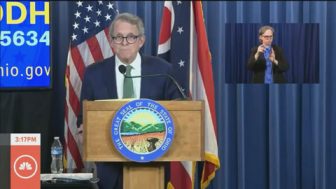OEA Applauds Governor’s Mask Order for Hot-Spot Counties
“The health and safety of students, educators, education support professionals, and the wider community must be the top priorities for any school reopening plans. For schools in the seven “hot-spot” counties where the risk of spreading the virus is greatest, requiring everyone – students and staff – to wear masks could save lives,” said OEA President Scott DiMauro.
Initial guidance from the governor’s office to shape reopening plans had encouraged students to wear masks, but they would not have been required. The new order from the governor strengthens the directive from the state.
“The evidence from public health experts makes clear that masks are, absent a vaccine, the best method we have so far to slow the spread of the coronavirus. Masks have been shown to help protect the people around an infected person from coming into contact with virus-laden respiratory droplets, which can disperse even when that person shows no symptoms,” DiMauro said. “After urging the governor to provide stronger enforcement of his school reopening guidelines, OEA is heartened to see him take this common-sense measure.”
As school districts around the state continue to develop their plans for how to safely reopen schools in the fall, OEA urges local officials to work collaboratively with educators on the policies and procedures that will best serve students.
OEA Urges Greater Accountability in Reopening Plans for Schools
“OEA understands and respects the long-standing adherence to local control in decision-making around public education, but the state also has a critical role to play amidst an unprecedented public health crisis and a rising number of cases of COVID-19,” said OEA President Scott DiMauro. “While we appreciate the consideration given to the importance of social distancing, health checks, and sanitation protocols in the Governor’s plan, it lacks a means of enforcement, even when a county is in the highest tier of the alert system.”
“Parents need to feel confident that schools are safe for their students to return to if we have any hope of successfully reopening the economy. They should not have to choose between their students’ health and their academic success,” DiMauro said. “A good number of Ohio’s educators are in the highest-risk group for severe complications from COVID-19. They should not have to choose between their livelihood and their health.”
OEA believes that it is more important than ever that educators have a seat at the table in local decisions, and to allow creative problem-solving through the collective bargaining process.
“We must ensure educators’ voices are heard in every school district as plans are developed to ensure a safe, successful school year,” DiMauro said. “We must also ensure resources are in place to implement critical safety measures. Federal lawmakers must step up and provide the needed funding for schools across Ohio.”
The U.S. House-passed HEROES Act would provide some of that education funding, but the Senate has failed to take up that bill for consideration. “We urge Sen. Rob Portman and his colleagues to act now on behalf of Ohio’s students,” DiMauro said.
Ohio Education Association Supports State Resolutions Declaring Racism a Public Health Crisis
“Racism hurts people of color in all aspects of their lives, including educational outcomes,” said OEA President Scott DiMauro. “Historic ‘redlining’ in many communities and systemic inequality put people of color at tremendous disadvantages. The deep-seated problems that have been exposed through a pandemic that adversely impacts communities of color and the recent incidents of police violence heighten the urgent need to address these issues.”
A study by the Centers for Disease Control and Prevention (CDC) on the effects of COVID-19 found a “disproportionate burden of illness and death among racial and ethnic minority groups.”
OEA recognizes the important role educators can play in addressing racial and economic inequities. “We can and should be confronting these issues head-on in our classrooms to expand Ohioans’ understanding of how racism affects individuals in our communities,” DiMauro said.
“Our teachers and education support professionals see first-hand every day how their students’ lives have been shaped by racism in our society,” DiMauro said, noting that Ohio’s schools play a critical role in providing health and nutrition services. “Where you were born and what you look like should not determine whether you can get access to high-quality education and adequate educational resources.”
According to the most recent data from the National Center for Education Statistics (NCES), 32 percent of African-American children in the U.S. live in poverty. There is ample evidence that poorer children tend to enter school with a readiness gap due to fewer community and family resources. That gap can be exacerbated in under-resourced classrooms, resulting in higher dropout rates. In the 2016-2017 school year, the graduation rate for black students in Ohio was 69 percent, while it was 88 percent for white students, according to an NCES report. The Ohio Association of Community Action Agencies’ 2019 State of Poverty report found that Ohioans without a high school diploma or GED are more than twice as likely to live in poverty than those who have finished high school.
In addition to the disproportionate impact of the coronavirus on communities of color, educational inequities have been further illuminated and exacerbated by distance learning in the face of the ongoing pandemic. There is a clear link between race, poverty, and health and OEA is committed to addressing these issues while promoting measures that set up all students for lifelong success.
“Our students deserve better,” said DiMauro, “and OEA believes recognizing racism as a public health crisis and creating a working group to address this issue are important first steps.”
June/July 2020 Ohio Schools
- COVER STORY: Celebrating School
- FEATURE: Extraordinary Measures in Extraordinary Times
- MAKING THE GRADE:
- OEA members gather for Ohio Association of Special Needs Professionals Annual Conference
- LEGISLATIVE UPDATE
- ASSOCIATION
Moved recently? Contact the OEA Member Hotline to update the address on file at 1-844-OEA-Info (1-844-632-4636) or email, membership@ohea.org. Representatives are available Monday-Friday, from 8:30 a.m. to 6 p.m. | OhioSchools — Past Issues
![]()
![]() Oh Yes, We’re Social — Join the Conversation!
Oh Yes, We’re Social — Join the Conversation!
![]()
Senate Bill 319 Would Provide Troubling Furlough Authority to School Districts
While the bill includes some positive provisions on teacher evaluations, high school graduation, and services to special needs students, OEA opposes a provision in the bill that would provide greater furlough authority to school districts and ESC boards through June 30, 2021.
We urge you to take action as an advocate for children and public education.
Please send a quick message to your state Senator asking him or her to support our students and schools by removing the furlough provision from SB 319.
‘A’ is for Advocacy – Why We Must All Become Activist Educators
By Julie Holderbaum, Minerva EA/OEA

During the past few months, Ohio’s teachers have found ways to creatively teach every content area while being separated physically from our students. It hasn’t been easy.
However, our struggles as teachers learning new technology and methods of teaching pale in comparison to the challenges of our students trying to learn from home. Few of them have a quiet workspace with a computer and ample time to engage with school assignments. Even in the best case scenarios, students are distracted by Netflix and TikTok, phones and video games. Most of my students face even greater challenges. They are taking care of younger siblings while their parents work, or they are working more hours at their own jobs to help with family expenses. Some of my students suffer from depression and anxiety, and now they are dealing with the world turned upside down. Sadly, in the worst cases, students are trapped at home with physically or mentally abusive family members and no escape to the safety of school.
Coupled with the fact that the learning environment at home can be problematic is the fact that there is great inequity in access to technology among Ohio’s families. A significant number of our students do not have access to the internet or the devices necessary to complete online work even in otherwise positive home learning environments.
A packet of work sent home is not the same as students being able to participate in a class meeting online or exchange emails with their teacher. It’s not the same as being able to view videos of their teachers explaining concepts, or watching their teachers work a math problem or edit a paragraph via a document camera.
Given the stressors that make learning from home difficult and the lack of technology that plagues many students, we can all agree that in-person education is in the best social and academic interest of our kids (and, frankly, our economy, because not every parent has a job that allows them to work from home when kids are not in school).
The task before us then is daunting and expensive: we need to deal with the technology gap in case a public health crisis again forces us to educate through remote learning, while at the same time make accommodations to ensure safe conditions for in-person learning.
I was hopeful that Governor DeWine would avoid making drastic cuts to school funding. I was even naive enough to hope the governor would find ways to provide more funding to public education.
 Instead, last week, the governor announced a “$300 million reduction in K-12 public-school funding, $210 million from Medicaid spending and $110 million from college and university funding.”[1] To my dismay, teachers, students, and the poorest Ohioans will bear the brunt of the budget cuts caused by the COVID-19 crisis.
Instead, last week, the governor announced a “$300 million reduction in K-12 public-school funding, $210 million from Medicaid spending and $110 million from college and university funding.”[1] To my dismay, teachers, students, and the poorest Ohioans will bear the brunt of the budget cuts caused by the COVID-19 crisis.
Interestingly, the Department of Corrections was spared from the budget ax, because “(prisons) have gotten to be more expensive to operate as state officials try to deal with COVID-19 outbreaks among prisoners and staff.”[2]
Aren’t schools going to become more expensive to operate as we try to deal with preventing outbreaks among students and staff? Schools are also a setting where a lot of people come in contact with each other in a relatively small space, which is why they were the first to be shut down when the dire nature of the situation became clear.
To return to school and keep our students and educators safe, nearly every aspect of the school day will need to be changed. Lunches, assemblies, large classes such as gym and choir, even one-on-one tutoring sessions will all have to be reconfigured. To achieve smaller class sizes, students might attend on alternate days or for half days. These modifications may require extra bussing, increased staffing, longer school operating hours, and at the very least, more daily cleaning and sanitizing. Furthermore, we need to be prepared to offer additional mental health services to help our students deal with the stress of returning to school or the trauma they endured while at home. Not knowing if or when something like this might happen again, we also need to ensure equal access to technology for all kids. And all of that equals MORE MONEY, not less.
Why not tap part of Ohio’s rainy-day fund? We are far beyond rain. We are past thunderstorms, tornadoes, and floods. We are close to “Sharknado” territory, and if that isn’t the time to use at least part of the rainy-day fund, when is? In actuality, we could use ALL of the rainy-day fund to avoid cuts in education and still have billions left over.
I know that OEA’s leadership agrees that we should tap into the rainy day fund. As Piet van Lier of Policy Matters Ohio noted “the state should have looked to the rainy-day fund now to help school funding, a move DeWine chose not to take,” and adding that “It’s just beyond comprehension that you could be doing that [cutting aid to schools] without turning over every stone.”[3]
Perhaps the cuts to school budgets made by the governor will be offset by the federal CARES (Coronavirus Aid, Relief, and Economic Security) Act. But the fact remains, if DeWine had not made the draconian cuts to education, any CARES money school districts receive could have actually been used to address the inequity issues and the need for creative solutions to resume in-person education, rather than to simply put local budgets on track to barely break even.
The governor likes to say we are “all in this together.” It doesn’t feel that way to me. It feels like educators, who have figured out how to completely change education in a matter of days, who are putting in more hours than ever before, who don’t even have time to say “we didn’t sign up for this,” are being taken advantage of. We’ve always stepped up, we’ve always figured out how to make do with the money we’re given, we’ve always done everything that has been asked of us and in such an outstanding manner that the governor has no reason not to expect that we won’t figure this out, too.
 We simply have to stop settling for monetary leftovers. We have to fight to make Ohio’s children the priority they should have been all along. We can’t count on Betsy DeVos or the current occupant of the White House to provide federal dollars to help the nation’s schools meet the new challenges we face. We can’t simply rely on union leaders or education-friendly state legislators to advocate for us and for our students. WE must fight for funding to address the new needs of our schools. WE must fight for safe conditions for us and our students to return to. WE must fight for equal access to technology for all kids.
We simply have to stop settling for monetary leftovers. We have to fight to make Ohio’s children the priority they should have been all along. We can’t count on Betsy DeVos or the current occupant of the White House to provide federal dollars to help the nation’s schools meet the new challenges we face. We can’t simply rely on union leaders or education-friendly state legislators to advocate for us and for our students. WE must fight for funding to address the new needs of our schools. WE must fight for safe conditions for us and our students to return to. WE must fight for equal access to technology for all kids.
We must let the governor and our elected representatives in Ohio and Washington DC know that we are willing to step up to the challenge that the COVID virus has brought to education, as we have demonstrated in stellar fashion during remote learning, but we need financial help to do so.
It is time to go on the offensive.
There are nearly 140,000 educators in Ohio[4]; imagine the power of some 140,000 people advocating for proper funding to take care of the needs of our students. We teach our students to stand up for what they believe in; are we doing that ourselves?
It’s worth contacting our U.S. Representatives and Senators to ask them to fight for funding from Congress. We have an even better chance of developing relationships with our state representatives and senators. A hand-written letter speaks volumes. An email also works and will allow you to quickly reach all of your legislators. Put your legislators’ office phone numbers in the Favorites on your phone so you can call them easily and frequently. Donate to the FCPE fund so that we can continue to elect legislators who support public education.
We need to make sure our leaders are hearing from educational experts. They might not seek out our opinion, but we must give it to them anyway, and hope that they have the good sense to listen to us when making decisions that impact education in Ohio.
The old cliche says that teachers shape the future. That has never been more true than now. It pains my heart to say it, but education may never be the same. We may never go back to “normal.” We have to prepare for that reality, and that means becoming teachers who advocate and argue for the funding we need to make the changes that will indeed shape the future of public education in a post-COVID 19 world.
— Julie Holderbaum is an English Instructor and an Academic Challenge Advisor at Minerva High School, Minerva, Ohio.
[1] “Ohio Gov. Mike DeWine announces $775m in state budget ….” 5 May. 2020, https://www.cleveland.com/open/2020/05/ohio-gov-mike-dewine-announces-775m-in-state-budget-cuts-to-education-medicaid-and-more.html. Accessed 6 May. 2020.
[2] “Ohio Gov. Mike DeWine announces $775m in state budget ….” 5 May. 2020, https://www.cleveland.com/open/2020/05/ohio-gov-mike-dewine-announces-775m-in-state-budget-cuts-to-education-medicaid-and-more.html. Accessed 6 May. 2020.
[3] “Coronavirus economic fallout ‘terrifies’ school leaders, experts ….” 8 May. 2020, https://www.cleveland.com/coronavirus/2020/05/coronavirus-economic-fallout-terrifies-school-leaders-experts-stirring-fears-of-deep-budget-cuts-merged-districts.html. Accessed 11 May. 2020.
[4] “Facts and Figures | Ohio Department of Education.” 11 Feb. 2020, http://education.ohio.gov/Media/Facts-and-Figures. Accessed 11 May. 2020.
April/ May 2020 Ohio Schools
- COVER STORY: OEA members focus on organizing and preparing for the future at 2020 Advocacy and Organizing Institute
- FEATURE: OEA endorses Andrew Smith for election to the State Teachers Retirement Board
- MAKING THE GRADE:
- Maple Heights paraprofessional names 2020 NEA Education Support Professional of the Year
- NEOEA celebrates 150 years
- LEGISLATIVE UPDATE
- ASSOCIATION
Moved recently? Contact the OEA Member Hotline to update the address on file at 1-844-OEA-Info (1-844-632-4636) or email, membership@ohea.org. Representatives are available Monday-Friday, from 8:30 a.m. to 6 p.m. | OhioSchools — Past Issues
![]()
![]() Oh Yes, We’re Social — Join the Conversation!
Oh Yes, We’re Social — Join the Conversation!
![]()
Taking Comfort in What We Know: Surviving as a Type A Teacher in Times of Uncertainty
By Julie Holderbaum, Minerva EA/OEA
 A week ago, I was trying to figure out how to rearrange my lesson plans to accommodate my trip to the State House on Wednesday to rally in support of public education.
A week ago, I was trying to figure out how to rearrange my lesson plans to accommodate my trip to the State House on Wednesday to rally in support of public education.
Today I’m in my empty classroom, trying to plan how to teach remotely for the foreseeable future.
Last week, it was important to me to teach the classics. It was important to me that I checked every box in the common core standards. It was important to me that my students did well on their Student Learning Objectives (SLO) so my evaluation would show that I’m a good teacher. It was important to prepare for state testing.
What seemed so imperative last week seems so insignificant today.
Still, while I’ve regained some perspective, I struggle. I’m a Type A teacher who thrives on planning. It’s difficult to plan when there are so many questions and so few answers. I can’t help but feel truly overwhelmed.
I have to take comfort in what we do know, and today, there are five things that I know with absolute certainty.
The world has not stopped. The sun will rise every day. The spring flowers will still grow. My trees will still blossom. There will be worms when it rains and that delicious smell of spring in the air. There will be rainbows.
This is temporary. While we do not know exactly when our classrooms will be filled with students, we know that there will come a day when our routines will go back to normal. Remote learning and teaching are not going to last forever. Someday we will once again stress over SLOs and state testing and jammed copiers and spotty wifi. Someday we will once again all be together under the Friday night lights cheering for our football team. The stormy waters we are being tossed about in will settle down.
This is an opportunity. It’s an opportunity for us to teach what really matters in our curriculum without worrying so much about the common core standards. I’m teaching my favorite poems and short stories and essays and I’m not worrying about whether or not they fit in with where we were in my prescribed and detailed and time-tested curriculum when we went on break. Not every content area lends itself to that freedom as much as English does, but surely in any grade and any subject, we can use this as an opportunity to teach the lessons and skills we are truly excited about, and we can get creative with this freedom.

People need human connections. I’ve never wanted to be with strangers at a concert or a movie theater more in my entire life. I’ve never wanted to hug my friends and co-workers as much as I do right now. I hope that when this is over, we will remember not to take for granted the pleasure that comes from human contact, from being in the same place at the same time, whether we are high-fiving strangers at Ohio Stadium after a Buckeye touchdown or raising voices and signs on the steps of the State House, advocating for our profession.
Our kids need us. They need us to maintain those human connections with them, because for many of them, school was the one place they felt safe and cared for.
They need us to show them how to persevere through challenging times, how to be flexible, how to keep a positive attitude. They need us to let them know that we are still here, that we still care, and that they are not alone.
So, in focusing on these five things I know, I hope to take action in ways that keep me from feeling too anxious in this time of uncertainty.
I will spend time outside, sun on my face, watching the progress of my tulips and letting my dog pull me along on a walk.
I will use this time to re-evaluate my teaching practice. This forced flexibility has made me realize that I’ve become too locked in to what I teach and how I teach it. I’m now able to search for new lesson ideas online and to try out the plethora of educational websites I’ve just never had time to explore. Most importantly, I am going to rethink whether spending so much time on the “classics” from the past (Paine, Poe, Emerson, Twain) is worth it when it means I never get time to teach more recent authors (Angelou, Atwood, Lamott, Allende). Someday we will be back in our classrooms with kids, but how I spend those days and what we study may not look the same at all.
I will do everything in my power to keep those human connections with my students, for my sake as well as theirs. I’m going to call and email and Remind and Google Classroom and Flipgrid until those teenagers I love are completely annoyed, but they will know I care and that is what matters.
 We know that academic and social development happens best in a school setting when students are engaging with their peers and teachers, and we just cannot provide that to them right now. But in the meantime, no one is better at meeting unexpected challenges than educators. Education has been derailed by state mandates in recent years, but this is a chance to get back to what it’s really all about, what it should always be about: the kids and their wellbeing. We didn’t go into teaching to provide politicians with data to determine if we have good schools or not. We went into teaching because we care about kids. If we keep that in mind, remote learning won’t feel so remote.
We know that academic and social development happens best in a school setting when students are engaging with their peers and teachers, and we just cannot provide that to them right now. But in the meantime, no one is better at meeting unexpected challenges than educators. Education has been derailed by state mandates in recent years, but this is a chance to get back to what it’s really all about, what it should always be about: the kids and their wellbeing. We didn’t go into teaching to provide politicians with data to determine if we have good schools or not. We went into teaching because we care about kids. If we keep that in mind, remote learning won’t feel so remote.
Maybe my students won’t get the exact same lessons they would have if we weren’t in this situation, but I have to be okay with that. I suspect that the lessons we all learn during this unplanned hiatus might be the kind that mean far more and last much longer than anything a perfectly planned unit can teach anyway.
— Julie Holderbaum is an English Instructor and an Academic Challenge Advisor at Minerva High School, Minerva, Ohio.
Conference Committee Testimony by Dan Heintz
By Dan Heintz, Chardon LSD
Distinguished members of Ohio’s 133rd General Assembly,
 My name is Dan Heintz. I am happy to share that I am a K-12 product of Ohio’s great public schools. I am also proud to say that I am a public school teacher at Chardon High School. Finally, I am honored to serve my neighbors as a member of the Cleveland Heights – University Heights Board of Education. As you can see my friends, public education flows through my veins and animates my spirit.
My name is Dan Heintz. I am happy to share that I am a K-12 product of Ohio’s great public schools. I am also proud to say that I am a public school teacher at Chardon High School. Finally, I am honored to serve my neighbors as a member of the Cleveland Heights – University Heights Board of Education. As you can see my friends, public education flows through my veins and animates my spirit.
Our Cleveland Heights – University Heights Schools have suffered under the burden of EdChoice in a way that few other districts have. Currently, 33% of our state funds are being diverted as a result of EdChoice. Our schools have fallen victim to a well-intentioned, but poorly conceived cult of accountability. Nowhere perhaps are these measures more inappropriately punitive than in Cleveland Heights – University Heights.
Cleveland Heights High School is an EdChoice school for one reason: Graduation Rate. Given this, one would expect our graduation rate to be low. It’s not. For the past 2 years in fact, our graduation rate has been higher than the state average, yet the state’s formula has nonetheless labeled ours as an underperforming EdChoice High School.
The College Board is the non-profit organization behind the SAT test, as well as all of the Advanced Placement coursework that many of our students take advantage of. Distinguished members of the General Assembly, four weeks ago, The College Board identified nine Ohio High Schools as AP Honor Roll High Schools. Cleveland Heights High School, labeled by the State as EdChoice eligible school, was one of these nine.
So, contrary to the State of Ohio’s label, the College Board doesn’t seem to think that ours is an underperforming high school at all, but what do America’s colleges and universities think? Are they confident that the graduates of Cleveland Heights High are prepared for success? You bet they are, and they put their money where their mouth is. My friends, Cleveland Heights High’s class of 2018 was offered a combined 10.4 million dollars of college scholarships. 10.4 million dollars. And the class of 2019 beat them! Our class of 2019 (roughly 350 students) was offered 12.1 million dollars in scholarship offers.
So, our graduation rate is above the state average, The College Board identifies us as an AP Honor Roll School, and our grads pulled in over 22 million dollars in scholarship offers over the past 2 years. But our own state government has determined that this is such a disappointing school that we need to provide a financial escape hatch in order for students to attend a private school. I simply cannot imagine that this is what we had in mind as the EdChoice system was being designed.
The pundits tell us that vouchers improve education by introducing competition. The narrative they promote is that families use vouchers to leave low performing public schools in order to attend higher-performing private schools. This narrative is pure sophistry. Facts are stubborn things, and the facts simply don’t support the narrative.
First, the overwhelming majority of our EdChoice voucher recipients are not leaving our schools at all, because leaving our schools would require them to have entered them in the first place. Committee members, 94% of our EdChoice vouchers are being used by students who have never been enrolled in one of our public schools. 94%. Furthermore, the private schools that receive this windfall of Ohio tax dollars are not always higher performing. According to the Ohio Department of Education, 61 of our students use EdChoice vouchers to attend a school whose 5th grade scores are lower than those of our district. That’s nearly a quarter of a million dollars! So let’s be clear, these people are not running from a failing school, they’re running from a tuition bill. Again, I cannot imagine that this is what we had in mind as the EdChoice system was being designed.
Ladies and gentlemen, my two-part request very simple: First, please rethink how we measure our public schools. And as you think that over, please come visit Cleveland Heights High. Second, if vouchers are to remain in the mix, please fund them directly from the state’s operating budget. The work that districts like mine do is hard enough without the additional challenges of depleted state aid.
Committee members, I thank you for your service to our state, and for your time today. If you have any questions, I am at your service.
— Dan Heintz is a Social Studies teacher at Chardon High School, Chardon, Ohio.
Why Ohio’s Report Card System Is Failing to Make the Grade
By Julie Holderbaum, Minerva EA/OEA
Ohio’s taxpayers want our schools to produce flourishing young adults who will contribute in meaningful and healthy ways to our society, and they spend a lot of money to ensure that this happens. It makes sense, therefore, that schools are required to undergo a yearly check-up and share the results with our communities.
 However, the current report card system is doing more to harm schools than to support them.
However, the current report card system is doing more to harm schools than to support them.
Any teacher or parent can tell you that a letter grade does not represent the entire child. A student can be quite intelligent, but if that child doesn’t turn in assignments on time, his grade will reflect not only his academic ability but his lack of responsibility. And that’s just classroom work; we all know that a child is more than classroom work. For example, a colleague of mine recently told me he saw my daughter comforting a friend in the hallway who was “freaking out” about a test her friend felt unprepared for. Jamie told me the story later of how she got her friend to take deep breaths and even laugh before going back to class. Frankly, I am prouder of that than any of the A’s on her report card.
Just as a student’s report card grades cannot show every aspect of awesome that lives in him, a school district report card cannot show all the beautiful and amazing moments that happen in our schools.
For example, the students in my small town’s elementary school have raised $95,000 for St. Jude’s over the last 12 years. Our middle school’s student council visits the local nursing homes and helps with the local food pantry once a month. Our high school seniors, twice per year, go into our community to rake leaves and plant flowers for the elderly, paint pavilions at the park, and more.
None of this shows up on our school district’s report card.
If I were choosing a new school district for my daughter, I would want to know what kind of opportunities are provided to teach children how to be good humans, not just good students.
I would want to know what kind of relationship the schools have with the community.
I would want to know not only what academic opportunities exist, but also what extra-curricular options are available.
I would want to know not only what academic support is provided for kids, but also what emotional support is in place to help children who live with poverty and trauma.
Our current report card system makes none of that information available to parents or community members. It is impossible to get a full picture of what wonderful things are happening in our schools.
Not only that, but the current system has damaged schools by basing many of the letter grades on testing, which has led to the loss of creative and playful activities in our classrooms and an increased and unhealthy focus on standardized tests. Tests are an easy factor to include on the report cards because they are a concrete measure, seemingly, of how a school is doing. What goes unmeasured is the stress the tests place on teachers and on students.
The current system even ties our hands when we try to do what is best for students regarding testing.
 My high school recently considered giving the ELA II test to our 9th graders, in order to give struggling students more opportunities to pass the test and to give those who pass during their freshman year fewer tests to take as 10th graders. However, once we realized that those students who passed their freshman year could potentially count as zeroes on our performance index their sophomore year, we decided not to go forward. We could not risk a possible F in the performance index area of the report card.
My high school recently considered giving the ELA II test to our 9th graders, in order to give struggling students more opportunities to pass the test and to give those who pass during their freshman year fewer tests to take as 10th graders. However, once we realized that those students who passed their freshman year could potentially count as zeroes on our performance index their sophomore year, we decided not to go forward. We could not risk a possible F in the performance index area of the report card.
Under the current system, any school building earning a D or an F in a report card indicator becomes eligible for EdChoice vouchers. Essentially, taxpayer money is pulled from a local public school and given in the form of a voucher to any private school a student wishes to attend instead. Thanks to the report card system, nearly ⅔ of Ohio’s school districts would be eligible for the vouchers in the 2020-21 school year. Consequently, the legislature was recently in crisis mode trying to address the problem before the February 1st deadline to apply for vouchers. Instead of solving the problem, however, they extended the deadline and bought themselves some time. This entire debacle could have been avoided if Ohio used an informative and fair evaluation system for its schools instead of a punitive one.
Furthermore, due to “failing” grades, three school districts in Ohio have now been taken over by the state. Many other districts are in danger of falling prey to HB 70, which allows local decisions by the school board to be over-ridden by an appointed (and well-paid) CEO. This is yet another harmful and unfair repercussion of the report card system.
Fortunately, widespread bipartisan support to change the way schools show accountability to their communities is gaining momentum in the Ohio legislature, perhaps because of the plethora of problems the report cards have caused.
 No reporting system will truly show all of the greatness happening in our schools, such as the money our students raise for cancer patients or the small moments of kindness in a hallway. However, OEA has crafted a plan that would include a myriad of indicators beyond test scores and graduation rates. “Report cards” and A-F grades would be gone. Instead, a fuller picture of what is happening in our schools would be available in School Profiles. Mandated information such as test scores and graduation rates would still be included, but so would information about early childhood education, AP/Honors courses offered, whole-child classes available (art, music, world languages, health/wellness), ratio of guidance counselors to students, average class size, and more.
No reporting system will truly show all of the greatness happening in our schools, such as the money our students raise for cancer patients or the small moments of kindness in a hallway. However, OEA has crafted a plan that would include a myriad of indicators beyond test scores and graduation rates. “Report cards” and A-F grades would be gone. Instead, a fuller picture of what is happening in our schools would be available in School Profiles. Mandated information such as test scores and graduation rates would still be included, but so would information about early childhood education, AP/Honors courses offered, whole-child classes available (art, music, world languages, health/wellness), ratio of guidance counselors to students, average class size, and more.
Ohio’s schools are more than a letter grade on a report card. We are not afraid of accountability. We are eager to show what we are accomplishing in spite of the many challenges we face. We only ask for a chance to show a more complete picture of what happens in our schools every day.
— Julie Holderbaum is an English Instructor and an Academic Challenge Advisor at Minerva High School, Minerva, Ohio.


